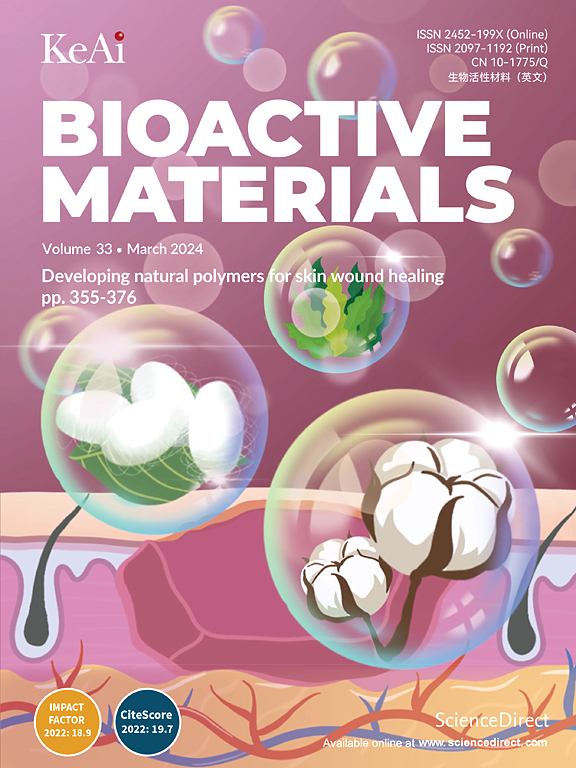End-tail soaking strategy toward robust and biomimetic sandwich-layered hydrogels for full-thickness bone regeneration
IF 18
1区 医学
Q1 ENGINEERING, BIOMEDICAL
引用次数: 0
Abstract
Despite an increasing number of tissue-engineered scaffolds have been developing for bone regeneration, simple and universal fabrication of biomimetic bone microstructure to repair full-thickness bone defects remains a challenge and an acute clinical demand due to the negligence of microstructural differences within the cortex of cancellous bone. In this work, a biomimetic sandwich-layered PACG-CS@Mn(III) hydrogel (SL hydrogel) was facilely fabricated in an end-tail soaking strategy by simply post-crosslinking of poly(acryloyl 2-glycine)-chitosan (PACG-CS) composite hydrogel using trivalent manganese solutions. Taking the merits of in-situ formation and flexible adjustment of chain entanglements, hydrogen bonds and metal chelate interactions, SL hydrogel with sandwich-like three-layered structures and anisotropic mechanical performance was easily customized through control of the manganese concentration and soaking time in fore-and-aft sides, simulating the structurally and mechanically biomimetic characteristics of cortical and cancellous bone. Furthermore, the produced SL hydrogel also demonstrated favorable biocompatibility and enhanced MnSOD activity via a peroxidase-like reaction, which enabled the excellent radical scavenging efficiency and anti-inflammatory regulation for facilitating the activity, proliferation and osteogenic differentiation of bone marrow mesenchymal stem cells (BMSCs). In vivo studies further revealed that these SL hydrogels achieved restrictive pro-vascular regeneration through their stratified structure, thereby promoting the differentiation of osteoblasts. Simultaneously, the mechanical cues of stratified structure could mediate macrophage phenotype transitions in accordance with stem cell-osteoblast differentiation process via the PI3K-AKT pathway, resulting in robust osteogenesis and high-quality bone reconstruction. This facile yet efficient strategy of turning anisotropic hydrogel offers a promising alternative for full-thickness repair of bone defects, which is also significantly imperative to achieve high-performance scaffolds with specific usage requirements and expand their clinic applicability in more complex anisotropic tissues.

面向全层骨再生的坚固仿生三明治层水凝胶的端尾浸泡策略
尽管越来越多的组织工程支架被用于骨再生,但由于忽视了松质骨皮质内微结构的差异,简单而普遍的制造仿生骨微结构来修复全层骨缺损仍然是一个挑战和迫切的临床需求。在这项工作中,通过使用三价锰溶液将聚丙烯酰2-甘氨酸-壳聚糖(PACG-CS)复合水凝胶简单交联,以端尾浸泡的方式制备了仿生三明治层PACG-CS@Mn(III)水凝胶(SL水凝胶)。利用链缠结、氢键和金属螯合物相互作用的原位形成和灵活调节的优点,通过控制前后两侧的锰浓度和浸泡时间,可轻松定制具有三明治状三层结构和各向异性力学性能的SL水凝胶,模拟皮质骨和松质骨的结构和力学仿生特性。此外,所制备的SL水凝胶还表现出良好的生物相容性,并通过过氧化物酶样反应增强MnSOD活性,从而具有良好的自由基清除效率和抗炎调节作用,促进骨髓间充质干细胞(BMSCs)的活性、增殖和成骨分化。体内研究进一步表明,这些SL水凝胶通过其分层结构实现限制性促血管再生,从而促进成骨细胞的分化。同时,层状结构的机械线索可以通过PI3K-AKT通路介导巨噬细胞表型转变,符合干细胞-成骨细胞分化过程,从而实现强健的成骨和高质量的骨重建。这种简单而高效的各向异性水凝胶转化策略为骨缺损全层修复提供了一种很有前景的替代方法,这对于实现具有特定使用要求的高性能支架以及扩大其在更复杂的各向异性组织中的临床适用性也具有重要意义。
本文章由计算机程序翻译,如有差异,请以英文原文为准。
求助全文
约1分钟内获得全文
求助全文
来源期刊

Bioactive Materials
Biochemistry, Genetics and Molecular Biology-Biotechnology
CiteScore
28.00
自引率
6.30%
发文量
436
审稿时长
20 days
期刊介绍:
Bioactive Materials is a peer-reviewed research publication that focuses on advancements in bioactive materials. The journal accepts research papers, reviews, and rapid communications in the field of next-generation biomaterials that interact with cells, tissues, and organs in various living organisms.
The primary goal of Bioactive Materials is to promote the science and engineering of biomaterials that exhibit adaptiveness to the biological environment. These materials are specifically designed to stimulate or direct appropriate cell and tissue responses or regulate interactions with microorganisms.
The journal covers a wide range of bioactive materials, including those that are engineered or designed in terms of their physical form (e.g. particulate, fiber), topology (e.g. porosity, surface roughness), or dimensions (ranging from macro to nano-scales). Contributions are sought from the following categories of bioactive materials:
Bioactive metals and alloys
Bioactive inorganics: ceramics, glasses, and carbon-based materials
Bioactive polymers and gels
Bioactive materials derived from natural sources
Bioactive composites
These materials find applications in human and veterinary medicine, such as implants, tissue engineering scaffolds, cell/drug/gene carriers, as well as imaging and sensing devices.
 求助内容:
求助内容: 应助结果提醒方式:
应助结果提醒方式:


